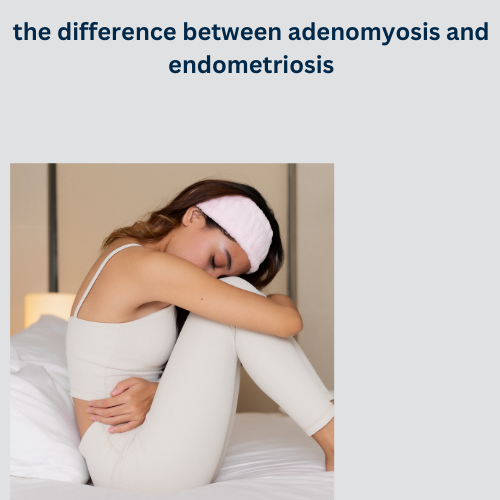The difference between adenomyosis and endometriosis
the difference between adenomyosis and endometriosis
Introduction
Adenomyosis and endometriosis are two gynecological conditions that affect many women worldwide. Although they share some similarities, they are distinct conditions with different characteristics, symptoms, and treatments. Understanding the differences between adenomyosis and endometriosis is crucial for accurate diagnosis and effective management. In this article, we will delve into the key differences between these two conditions, their causes, symptoms, and available treatment options.

What is Adenomyosis?
Adenomyosis is a condition where the inner lining of the uterus (endometrium) breaks through the muscle wall of the uterus (myometrium). This abnormal growth causes the uterine walls to thicken and can lead to heavy bleeding and pain during menstruation. Adenomyosis is typically found in women in their late 30s to 50s and is often associated with childbirth and uterine surgery.
Causes of Adenomyosis
The exact cause of adenomyosis is not well understood, but several theories exist:
- Invasive Tissue Growth: Endometrial cells invade the uterine muscle.
- Developmental Origins: Endometrial tissue is deposited in the uterine muscle during fetal development.
- Inflammation: Inflammation of the uterine lining during childbirth can lead to adenomyosis.
- Hormonal Factors: High levels of estrogen may promote the growth of endometrial tissue.
Symptoms of Adenomyosis
Women with adenomyosis may experience a range of symptoms, including:
- Heavy Menstrual Bleeding: Prolonged or heavy menstrual periods.
- Severe Menstrual Cramps: Intense pain during menstruation.
- Pelvic Pain: Chronic pain in the pelvic area.
- Enlarged Uterus: The uterus may become enlarged and tender.
What is Endometriosis?
Endometriosis is a condition where the tissue similar to the lining inside the uterus (endometrium) begins to grow outside the uterus. This tissue can be found on the ovaries, fallopian tubes, outer surface of the uterus, and other pelvic organs. Endometriosis can cause significant pain and is a leading cause of infertility.
Causes of Endometriosis
The causes of endometriosis are also not fully understood, but several theories include:
- Retrograde Menstruation: Menstrual blood flows backward through the fallopian tubes into the pelvic cavity.
- Embryonic Cell Transformation: Hormones transform embryonic cells into endometrial-like cell implants during puberty.
- Surgical Scars: After surgeries like a hysterectomy or C-section, endometrial cells may attach to the surgical incision.
- Immune System Disorders: Problems with the immune system may make the body unable to recognize and destroy endometrial-like tissue growing outside the uterus.
Symptoms of Endometriosis
Endometriosis symptoms can vary but often include:
- Pelvic Pain: Pain before and during menstruation.
- Pain with Intercourse: Pain during or after sex.
- Pain with Bowel Movements or Urination: Especially during menstrual periods.
- Excessive Bleeding: Heavy periods or bleeding between periods.
- Infertility: Difficulty in becoming pregnant.
- Other Symptoms: Fatigue, diarrhea, constipation, bloating, and nausea.
Key Differences Between Adenomyosis and Endometriosis
While adenomyosis and endometriosis both involve the growth of endometrial tissue outside its normal location, they have distinct differences:
Location of Tissue Growth
- Adenomyosis: Endometrial tissue grows within the uterine muscle wall.
- Endometriosis: Endometrial tissue grows outside the uterus on pelvic organs.
Age of Onset
- Adenomyosis: Commonly affects women in their late 30s to 50s, often those who have had children.
- Endometriosis: Often diagnosed in women in their 20s to 30s, but symptoms can begin in adolescence.
Associated Conditions
- Adenomyosis: Often associated with childbirth and uterine surgery.
- Endometriosis: Can be associated with infertility and ovarian cysts (endometriomas).
Diagnosis
- Adenomyosis: Diagnosed through pelvic exams, ultrasound, and MRI. Sometimes confirmed after hysterectomy.
- Endometriosis: Diagnosed through pelvic exams, ultrasound, MRI, and laparoscopy (surgical procedure).
Symptoms
- Adenomyosis: Heavy menstrual bleeding, severe menstrual cramps, pelvic pain, enlarged uterus.
- Endometriosis: Pelvic pain, pain with intercourse, pain with bowel movements or urination, excessive bleeding, infertility.
Treatment Options
Adenomyosis Treatment
Treatment for adenomyosis focuses on relieving symptoms and may include:
- Medications: NSAIDs for pain relief, hormone therapy to reduce menstrual flow.
- Uterine Artery Embolization: A procedure to block blood flow to the affected areas.
- Endometrial Ablation: A procedure to destroy the lining of the uterus.
- Hysterectomy: Surgical removal of the uterus, considered the definitive treatment.
Endometriosis Treatment
Treatment for endometriosis aims to manage pain and improve fertility and may include:
- Medications: Pain relievers, hormone therapy to reduce or eliminate menstruation.
- Conservative Surgery: Removal of endometrial growths while preserving the uterus and ovaries.
- Fertility Treatment: Assisted reproductive technologies like IVF for women experiencing infertility.
- Hysterectomy: In severe cases, removal of the uterus and possibly the ovaries.
Conclusion
Understanding the differences between adenomyosis and endometriosis is crucial for effective diagnosis and treatment. While both conditions involve the abnormal growth of endometrial tissue, their locations, symptoms, and treatment options vary significantly. If you experience symptoms related to either condition, consulting with a healthcare provider is essential for appropriate management and care.